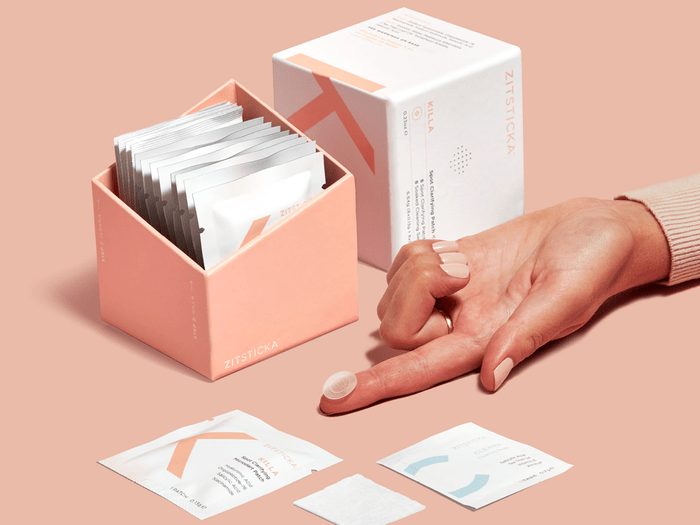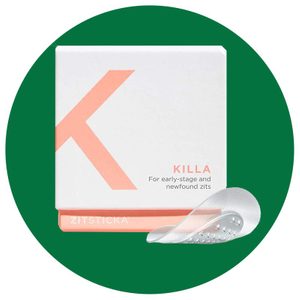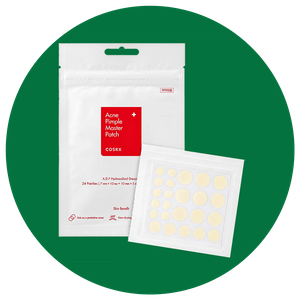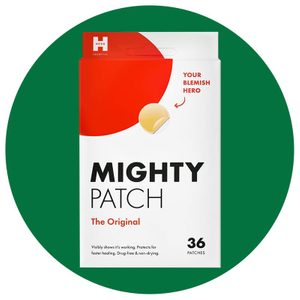Do Pimple Patches Actually Work?

Pimple patches, or zit stickers, are trending in skin care, but how well they work depends on the type of acne you have.
A quick glance around the skin-care section of your local drugstore or go-to beauty website and you’re likely to see many of the same acne-fighting products you’re used to. These include face washes, lotions, sheet masks, and spot treatments. But there’s one new-to-market acne product that might catch you off guard, because, well, it’s in sticker form. They’re known as pimple patches or zit stickers, and they’re increasing in popularity thanks to a myriad of celebs, like Riverdale TV star Lili Reinhart, attesting to their impressive pimple-shrinking abilities.
(Related: 10 Dermatologist-Approved Face Masks for Acne)
What is a pimple patch?
Just as the name suggests, a pimple patch is an adhesive sticker that you apply directly to a pimple and leave on for a period of time to reduce the breakout. There are several different brands of pimple patches, as well as ingredients used to treat the pimples themselves. One main ingredient used in pimple patches includes hydrocolloid—the same ingredient used in wound healing bandages.
“Hydrocolloid is designed to provide a protective barrier and absorb fluid and oils from the pimple while reducing inflammation associated with a breakout,” explains Marisa Garshick, MD, dermatologist at Medical Dermatology & Cosmetic Surgery (MDCS) in New York. “Hydrocolloid patches are a great option for red, inflamed breakouts, as they help draw out excess oil without irritating the skin and expedite the healing process.”
Other patches may include one of two better-known acne-fighting ingredients: salicylic acid and benzoyl peroxide. “Salicylic acid is a beta-hydroxy acid and exfoliant is oil-soluble and helps to unclog the pores, reduce breakouts, especially whiteheads and blackheads, and can improve the appearance of blemishes, explains Dr. Garshick. “Benzoyl peroxide is an antiseptic that’s been used to treat acne for decades, however, it is best to avoid it if you have experienced prior irritation to it.”
(Related: 7 Skin Conditions That Look Like Acne But Aren’t)
Why are pimple patches becoming so popular?
According to Brendan Camp, MD, a Manhattan-based dermatologist at MDCS Dermatology, pimple patches are seeing a rise in popularity for several reasons. “One of the main reasons is because of the increase in maskne, or the result of excess acne-causing bacteria in the area of the face that lies underneath a standard face mask—i.e. the nose, cheeks, and chin,” he says. “In addition, the self-care movement has taken off as more people spend time at home and find ways to better themselves and their skin.” There’s also no denying the sheer convenience of these pimple patches. Instead of applying a thick lotion or gel over your pimples, you can simply don a patch that appears skin-coloured and essentially hides your breakout, making it less visible.
(Related: Here’s When You Can Expect Your Hormonal Acne to Finally Go Away)
Do pimple patches really work?
Most dermatologists are in favour of using pimple patches to treat inflammatory acne lesions. “They help acne heal faster especially if there’s a lot of pus or inflammation in the lesion, however, if it’s a dry lesion or a whitehead or blackhead, it doesn’t do as much,” notes Papri Sarkar, MD, Boston-based dermatologist. “These patches are also great because they keep patients from playing with or picking their spots—a habit that can make acne lesions harder to heal or leave a scar.”
While pimple patches are marketed to treat pimples, in general, it’s worth noting that not all pimples are created equal. For this reason, pimple patches are not effective on all types of acne. According to Dr. Camp pimple patches are best suited for treating superficial inflammatory acne papules, meaning red swollen bumps that sit near the surface of the skin.
“These juicy blemishes are ripe for treatment because inflammation is associated with edema, which is swelling or puffiness due to increased fluid in the skin,” he explains. “They are not as effective for cystic or deeper-seated acne because ingredients such as hydrocolloid cannot penetrate far enough into the skin to reach this type of acne.”
It’s also worth noting that there’s not much scientific data available to date to support the clinical effectiveness of pimple patches. There is, however, one preliminary study published in the Journal of Cosmetic Science that analyzed the results of 10 patients who used acne patches for one week and found that they reduced the overall severity of the acne.
(Related: How To Get Rid of Cystic Acne, Sometimes Overnight)
The best pimple patch brands
If you’re considering hopping on the pimple-patch bandwagon, here are the brands dermatologists say are worth trying, especially if you’re experiencing reoccurring acne.

ZitSticka Killa Patch
This ZitSticka pimple patch contains self-dissolving micro darts that are applied to the pimple and delivers a combination of salicylic acid to help gently exfoliate, hyaluronic acid to hydrate, and niacinamide to soothe, explains Dr. Garshick. The full kit also includes a “CLEANA” swab that can be applied to the area prior to applying the patch. “Once the patch is applied, it should be left on for at least 2 hours to allow the micro darts to dissolve, but may be best to leave on overnight,” she says.
ZitSticka Killa Spot Clarifying Patch Kit, $46, net-a-porter.com

CosRx Acne Pimple Master Patch
“This easy-to-use hydrocolloid patch creates a protective barrier and helps to draw out excess oil to help reduce breakouts and blemishes,” explains Dr. Garshick. It can be used on breakouts that are located on the face as well as the body and works to help reduce redness and inflammation. While it’s helpful that CoxRx sells different sized patches so that you can target your pimple based on its diameter, Dr. Garshick recommends selecting a bigger size patch for most spots.
Cosrx Acne Pimple Master Patch, $6, amazon.ca

Hero Mighty Patch Original
This hydrocolloid-containing Mighty Patch works like many others, helping to draw out fluid from the pimple to improve its appearance. While it is latex-free, Dr. Garshick warns those with allergies to pectin or rubber to be cautious when using this. Otherwise, she says this is a great option for all skin types. She is also a fan of their other patch lines including their Mighty Patch Micropoint for Dark Spots, which helps reduce scarring after the acne has healed.
Hero Mighty Patch Original, $18, indigo.ca
Next: The Best Acne Scar Treatment for Even the Toughest Scars




